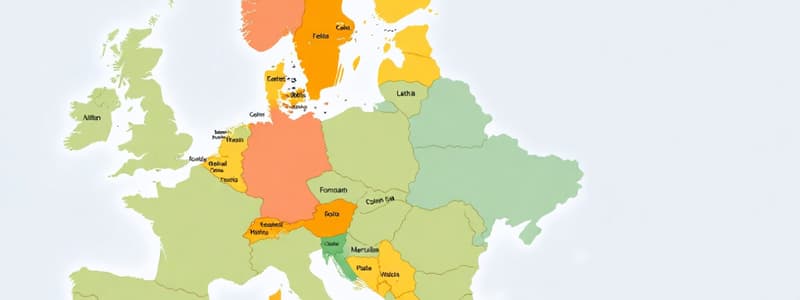Podcast
Questions and Answers
What does the birth rate represent?
What does the birth rate represent?
- The average number of children per woman in a region
- The number of births relative to the population expressed in per mille (correct)
- The total number of births per year in a country
- The number of deaths relative to the total population
How is the fertility rate defined?
How is the fertility rate defined?
- It represents live births per women aged 15-49 expressed in per mille (correct)
- It is the number of deaths per thousand inhabitants
- It reflects the total population growth percentage
- It is the average number of children per family
What average number of children per woman indicates a replacement level of the population?
What average number of children per woman indicates a replacement level of the population?
- 2.1 children per woman (correct)
- 2.5 children per woman
- 1.5 children per woman
- 3.0 children per woman
What does the infant mortality rate indicate?
What does the infant mortality rate indicate?
What does the infant mortality rate measure?
What does the infant mortality rate measure?
How is natural population growth defined?
How is natural population growth defined?
What does the net migration rate reflect?
What does the net migration rate reflect?
Which shape can a population pyramid represent during demographic transition?
Which shape can a population pyramid represent during demographic transition?
What is life expectancy at birth mainly indicative of?
What is life expectancy at birth mainly indicative of?
What is the birth rate expressed in?
What is the birth rate expressed in?
What is the formula to calculate the fertility rate?
What is the formula to calculate the fertility rate?
Which rate provides information about the number of infants who died before their first birthday?
Which rate provides information about the number of infants who died before their first birthday?
What average number of children per woman is necessary for population replacement?
What average number of children per woman is necessary for population replacement?
Flashcards
Birth rate
Birth rate
Number of births per 1,000 people in a place.
Fertility rate
Fertility rate
Average number of births per woman aged 15-49.
Average children perwoman
Average children perwoman
Average number of children per woman needed for population replacement is 2.1.
Death rate
Death rate
Signup and view all the flashcards
Infant mortality rate
Infant mortality rate
Signup and view all the flashcards
Life Expectancy
Life Expectancy
Signup and view all the flashcards
Natural Population Growth
Natural Population Growth
Signup and view all the flashcards
Net Migration Rate
Net Migration Rate
Signup and view all the flashcards
Population Pyramid
Population Pyramid
Signup and view all the flashcards
What does 'per mille' mean?
What does 'per mille' mean?
Signup and view all the flashcards
Study Notes
Geography Exam Guide
- Map of Europe: Identify 20 European countries and their capitals.
- Map of Spanish Provinces: Identify 15 Spanish provinces.
- Definitions: Define concepts from a provided list.
- Birth Rate: Number of births relative to the population (per 1000)
- Fertility Rate: Number of live births per woman aged 15-49 (per 1000)
- Average Number of Children per Woman: Average needed for population replacement (typically 2.1)
- Death Rate: Number of deaths relative to the population (per 1000)
- Infant Mortality Rate: Number of deaths of infants under 1 year old per 1000 births.
- Life Expectancy: Average expected lifespan at birth.
- Natural Population Growth: Difference between births and deaths.
- Net Migration Rate: Difference between people entering and leaving a country.
- Long Answer: Choose one long answer question from a provided list.
- Territorial Organization in Spain
- Population Registers in Spain
- Distribution of the Population in Spain
- Test Questions: Answer 6-7 questions related to the unit.
- Population Pyramid: Draw a pyramid given data, identify the shape (triangular, pointed arch/bell, urn, bulb), and associated demographic model (old, transition, modern).
Studying That Suits You
Use AI to generate personalized quizzes and flashcards to suit your learning preferences.




